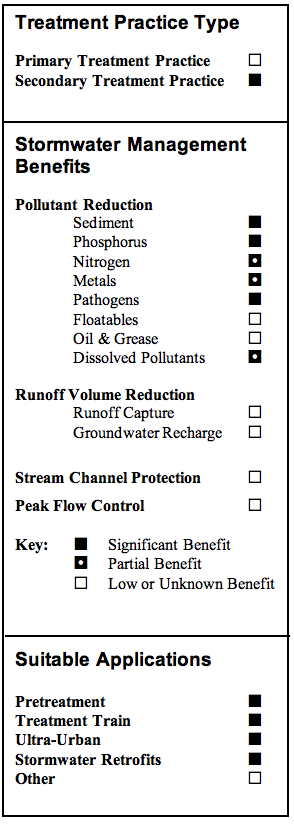Description

Stormwater ponds are vegetated ponds that retain a permanent pool of water and are constructed to provide both treatment and attenuation of stormwater flows. This section addresses four types of stormwater ponds:
* Wet Pond
* Micropool Extended Detention Pond
* Wet Extended Detention Pond
* Multiple Pond System
Through careful design, stormwater ponds can be effective at removing urban pollutants. Treatment is primarily achieved by the sedimentation process where suspended particles and pollutants settle to the bottom of the pond. Stormwater ponds can also potentially reduce soluble pollutants in stormwater discharges by adsorption to sediment, bacterial decomposition, and the biological processes of aquatic and fringe wetland vegetation.
The key to maximizing the pollutant removal effectiveness of stormwater ponds is maintaining a permanent pool. To achieve this, wet ponds typically require a large contributing watershed with either an impermeable liner or an elevated water table without a liner. The pool typically operates on the instantaneously mixed reservoir principle where incoming water mixes with the existing pool and undergoes treatment through sedimentation and the other processes. When the existing pool is at or near the pond outlet or when the primary flow path through the pond is highly linear, the pond may act as a plug flow system in which incoming water displaces the permanent pool, which is then discharged from the pond. The value provided by this process is that a portion of the “new,” polluted runoff is retained as the “old,” treated water is discharged from the pond, thereby allowing extended treatment of the water quality volume (WQV). For example, when sized to store the WQV, a pond system will retain all of the water from storms that generate runoff less than or equal to the WQV and result in a significantly increased period of time available for treatment. For storms that generate runoff greater than the WQV, wet ponds still provide a reduced level of treatment through conventional settling and filtration for the additional runoff volume that is conveyed through the pond. The pond volume should be greater than or equal to the WQV to ensure at least one-day retention time within the pond.
When properly designed, the permanent pool reduces the velocity of incoming water to prevent resuspension of particles and promote settling of newly introduced suspended solids. The energy dissipating and treatment properties of the permanent pool are enhanced by aquatic vegetation, which is an essential part of the stormwater pond design. In contrast, dry detention ponds, or dry extended detention ponds that have no permanent pool, are not considered an acceptable option for treating the WQV due to the potential for resuspension of accumulated sediment by incoming storm flows during the early portion of a storm event when the pond is empty.
Several design variations of stormwater ponds exist that can fit a wide range of design conditions. Descriptions of these design variations are provided in the following section.
Design Variations
* Wet Ponds: Wet ponds typically consist of two general components - a forebay and a permanent wet pool. The forebay provides pretreatment by capturing coarse sediment particles in order to minimize the need to remove the sediments from the primary wet pool. The wet pool serves as the primary treatment mechanism and where much of the retention capacity exists. Wet ponds can be sized for a wide range of watershed sizes, if adequate space exists. For example, a variation on the conventional wet pond, sometimes referred to as a “pocket pond”, is intended to serve relatively small drainage areas (between one and five acres). Because of these smaller drainage areas and the resulting lower hydraulic loads of pocket ponds, outlet structures can be simplified and often do not have safety features such as emergency spillways and low level drains. Figure 11-P1-1 depicts a typical schematic design of a conventional wet pond, while Figure 11-P1-2 shows a typical schematic design of a modified wet pond or “pocket pond”.

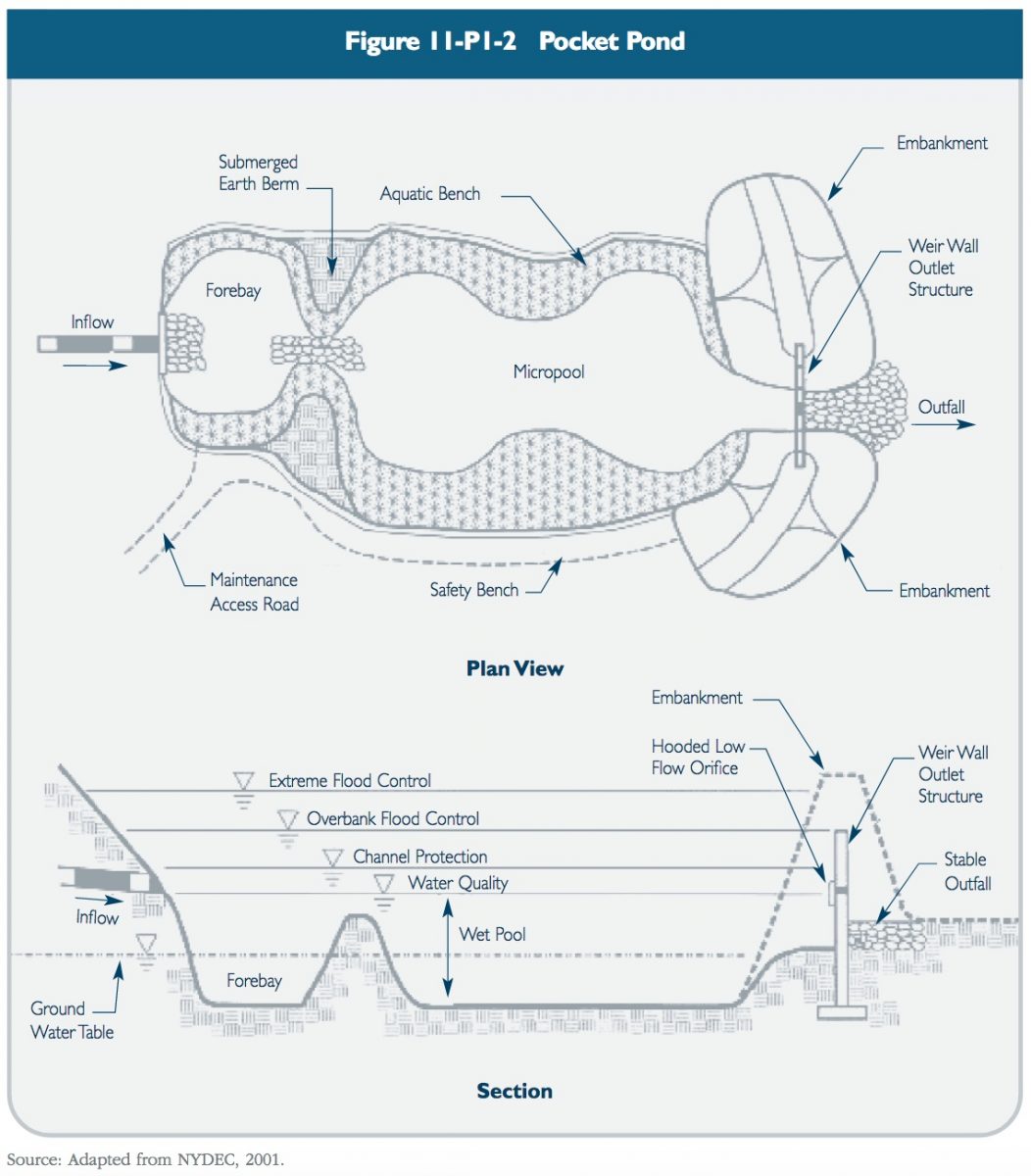
Several adaptations of this basic design have been developed to achieve the specific treatments goals of various watershed or site conditions. These wet pond design variations are described below.
* Micropool Extended Detention Pond: Micropool extended detention basins are primarily used for peak runoff control and utilize a smaller permanent pool than conventional wet ponds. While micropool extended detention ponds are not as efficient as wet ponds for the removal of pollutants, they should be considered when a large open pool might be undesirable or unacceptable. Undesirable conditions could include thermal impacts to receiving streams from a large open pool, safety concerns in residential areas, or where maintaining a large open pool of water would be difficult due to a limited drainage area or deep groundwater.
Micropool extended detention ponds are also efficient as a stormwater retrofit to improve the treatment performance of existing detention basins. Figure 11-P1-3 depicts a typical schematic design of a micropool extended detention pond.
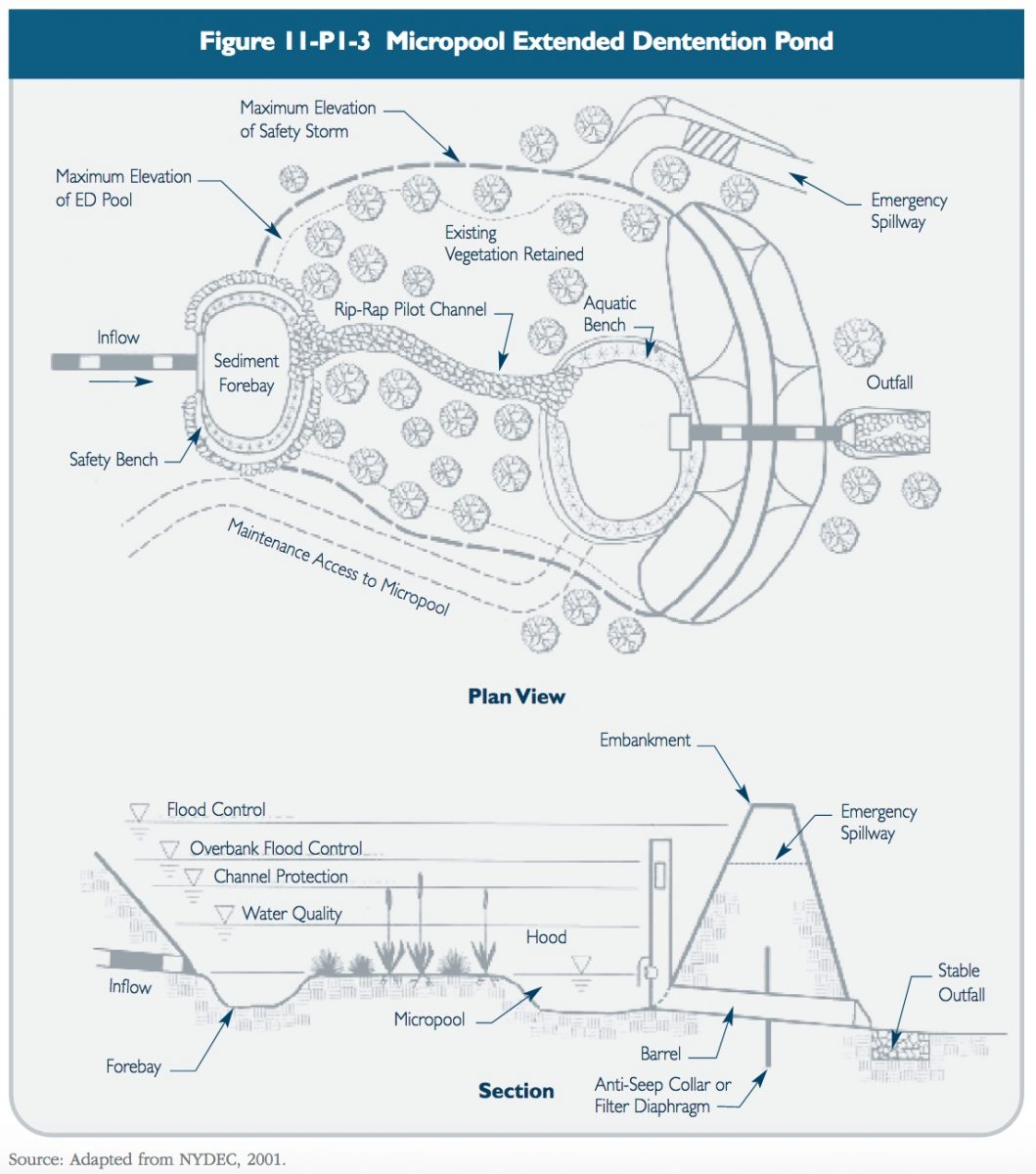
* Wet Extended Detention Ponds: These ponds are very similar to wet ponds with the exception that their design is more focused on attenuating peak runoff flows. As a result, more storage volume is committed to managing peak flows as opposed to maximizing the wet pool depth. The configuration of the outfall structure may also differ from typical wet pond designs to provide additional storage volume above the level of the permanent pool. Figure 11-P1-4 depicts a typical schematic design of a wet extended detention pond.
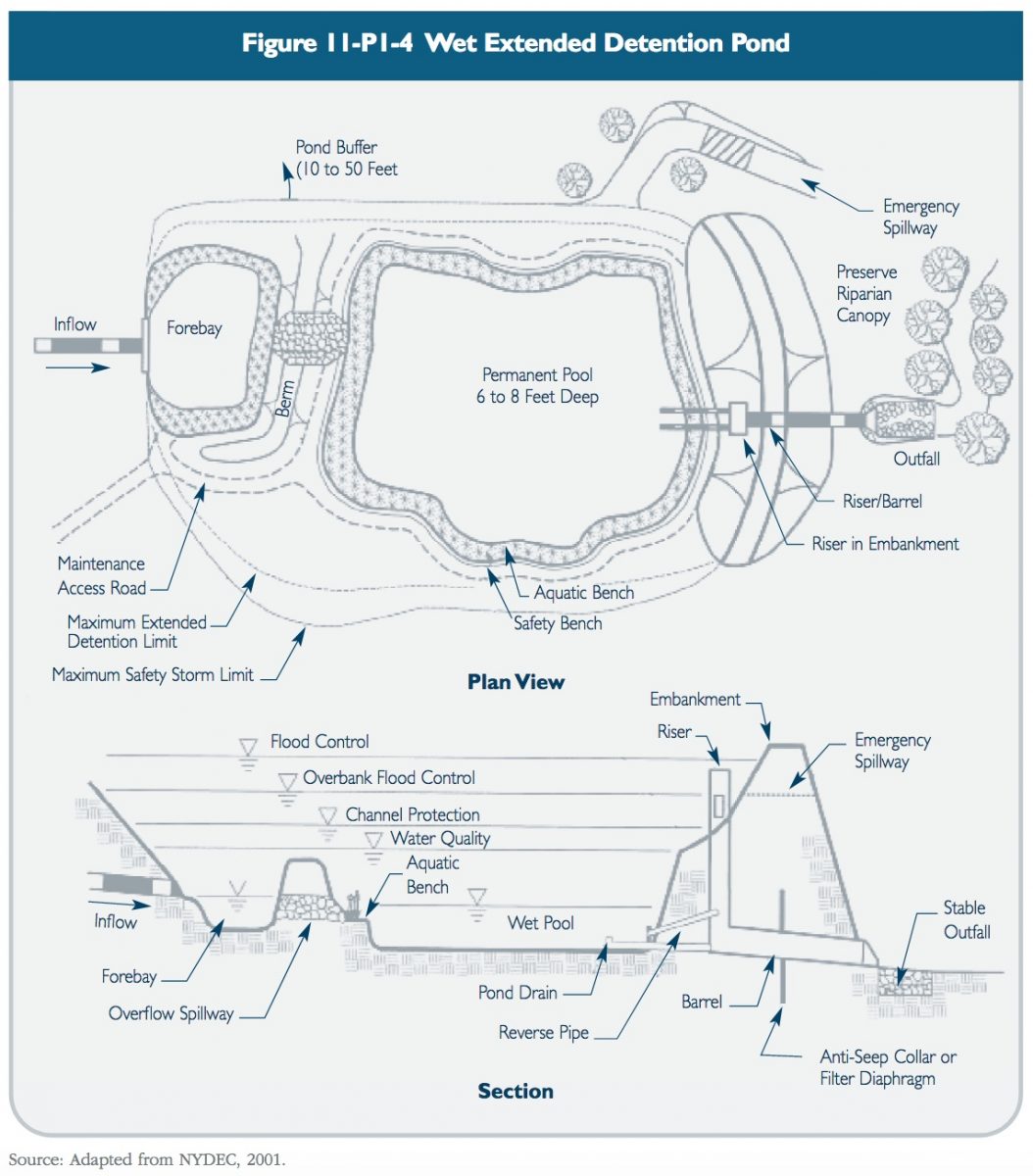
* Multiple Pond System: Multiple pond systems consist of several wet pools that are constructed in series following a forebay. The advantage of these systems is that they can improve treatment efficiency by better simulating plug flow conditions as compared to a single large wet pool. Also, these systems can reduce overall maintenance needs since more frequent maintenance would be performed within the first pool cells as opposed to the large, primary pool. The disadvantage of these systems is that they typically require more land area to treat the same water quality volume. Figure 11-P1-5 depicts a typical schematic design of a multiple pond system.
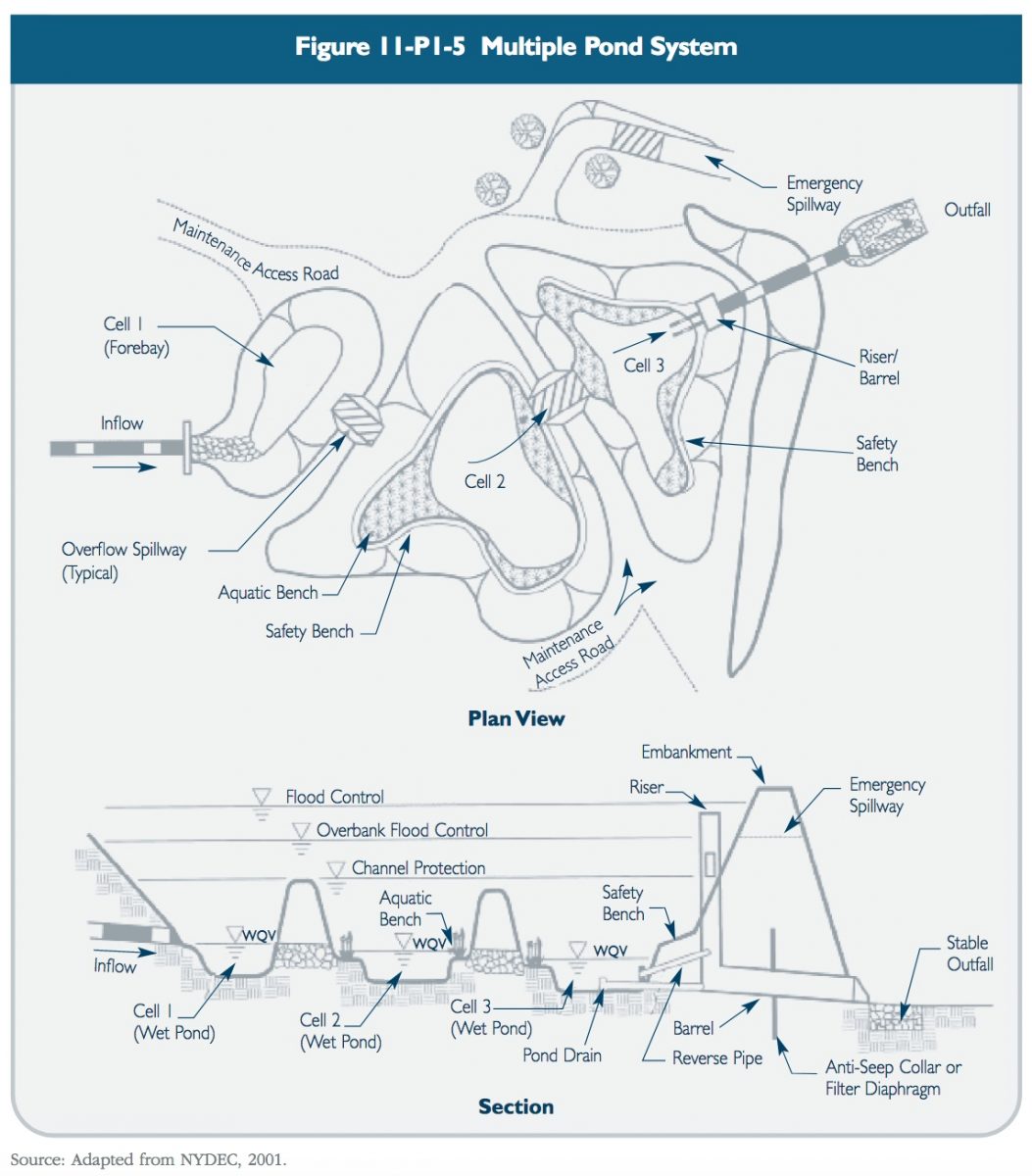
Advantages
* Can capture/treat both particulate and soluble pollutants. Stormwater ponds are one of the most effective stormwater treatment practices for treating soluble pollutants.
* Can provide an aesthetic benefit if open water is desired as part of an overall landscaping plan.
* May provide wildlife habitat with appropriate design elements.
* Can be adapted to fit a wide range of sites. Design variations allow this control to be utilized for both small and large drainage areas. Pollutant removal mechanisms make stormwater ponds efficient in treatment of pollutants-of-concern from a wide range of land uses.
Limitations
* Unlined ponds that intercept groundwater have potential to impact groundwater quality if dissolved pollutants are present in the runoff.
* Lined ponds typically require a minimum drainage area in order to maintain a permanent pool, which may become difficult during extended dry periods.
* Requires a relatively large land area that is directly proportional to the size of the area draining to it.
* May cause thermal impacts to receiving waters and thereby are not recommended to discharge directly to cold water fish habitats.
* Requires more storage volume (i.e., above permanent pool) to attenuate peak flows.
* Potential breeding habitat for mosquitoes, particularly for smaller ponds with stagnant water or isolated pockets of standing water (rather than large open water bodies). Circulating water in the permanent pool may minimize this problem. This may be a more significant problem for lined basins.
* Pollutant removal efficiency can be affected in cold climates due to ice formation on the permanent pool and longer particle settling times associated with higher density water during winter months. However, modifications to a pond’s design can help maintain the primary pollutant removal mechanism of sedimentation.
* Ponds with steep side slopes and/or deep wet pools may present a safety issue to nearby pedestrians.
* Stormwater ponds can serve as decoy wetlands, intercepting breeding amphibians moving toward vernal pools. If amphibians deposit their eggs in these artificial ponds/wetlands, they rarely survive due to the sediment and pollutant loads, as well as fluctuations in water quality, quantity, and temperature.
Siting Considerations
* Drainage Area: Stormwater ponds that utilize a liner system should have a contributing drainage area that is adequate to maintain minimum water levels. Typically, minimum contributing watersheds for unlined ponds are twenty-five acres for wet ponds, wet extended detention ponds, and multiple pond systems; ten acres for micropool extended detention ponds; and one to five acres for pocket ponds.
* Groundwater: Unlined basins must intersect the groundwater table in order to maintain the desired permanent pool. In this case, the elevations of the basin should be established such that the groundwater elevation is equal to the desired permanent pool elevation. Seasonal variations of groundwater elevations should be considered, which can be very pronounced in low permeability soils.
* Land Uses: Land uses will both dictate potential pollutants-of-concern as well as potential safety risks. For those land uses where there is significant potential for soluble pollutants, especially those that are highly susceptible to groundwater transport, the use of a liner is recommended. An impermeable liner may not be required depending on risk of downstream contamination, but a low permeability liner constructed in till soils may be acceptable. With regard to potential safety issues, adjacent residential land uses pose the greatest risks where mosquito breeding and water hazards must be considered.
* Baseflow: A small amount of baseflow is desirable to maintain circulation and reduce the potential for low dissolved oxygen levels during late summer. This baseflow can be provided by groundwater infiltrating into either the basin or the collection system above the pond.
* Site Slopes: Steep on-site slopes may result in the need for a large embankment to be constructed to provide the desired storage volume, which could require a dam construction permit from the Connecticut DEP. Steep slopes may also present design and construction challenges, as well as significantly increase the cost of earthwork.
* Receiving Waters: The sensitivity of receiving waters should be evaluated to determine whether the effects of the warmer stormwater discharges from the wet pond could be detrimental to cold water fish or other sensitive aquatic species.
* Flood Zones: Ponds should not be located in floodways, floodplains, or tidal lands, especially those that require construction of an embankment. Floodwaters could flush out stored pollutants or damage pond embankments.
* Natural Wetlands/Vernal Pools: Natural wetlands and vernal pool depressions should not be used, either temporarily or permanently, as a stormwater pond or wetland. Stormwater ponds should be located at least 750 feet from a vernal pool. They should not be sited between vernal pools or in areas that are primary amphibian overland migration routes, if known.
Design Criteria
Pond designs may vary considerably due to site constraints, local requirements, or the designer’s preferences. Design considerations for stormwater ponds are presented below and summarized in Table 11-P1-1.
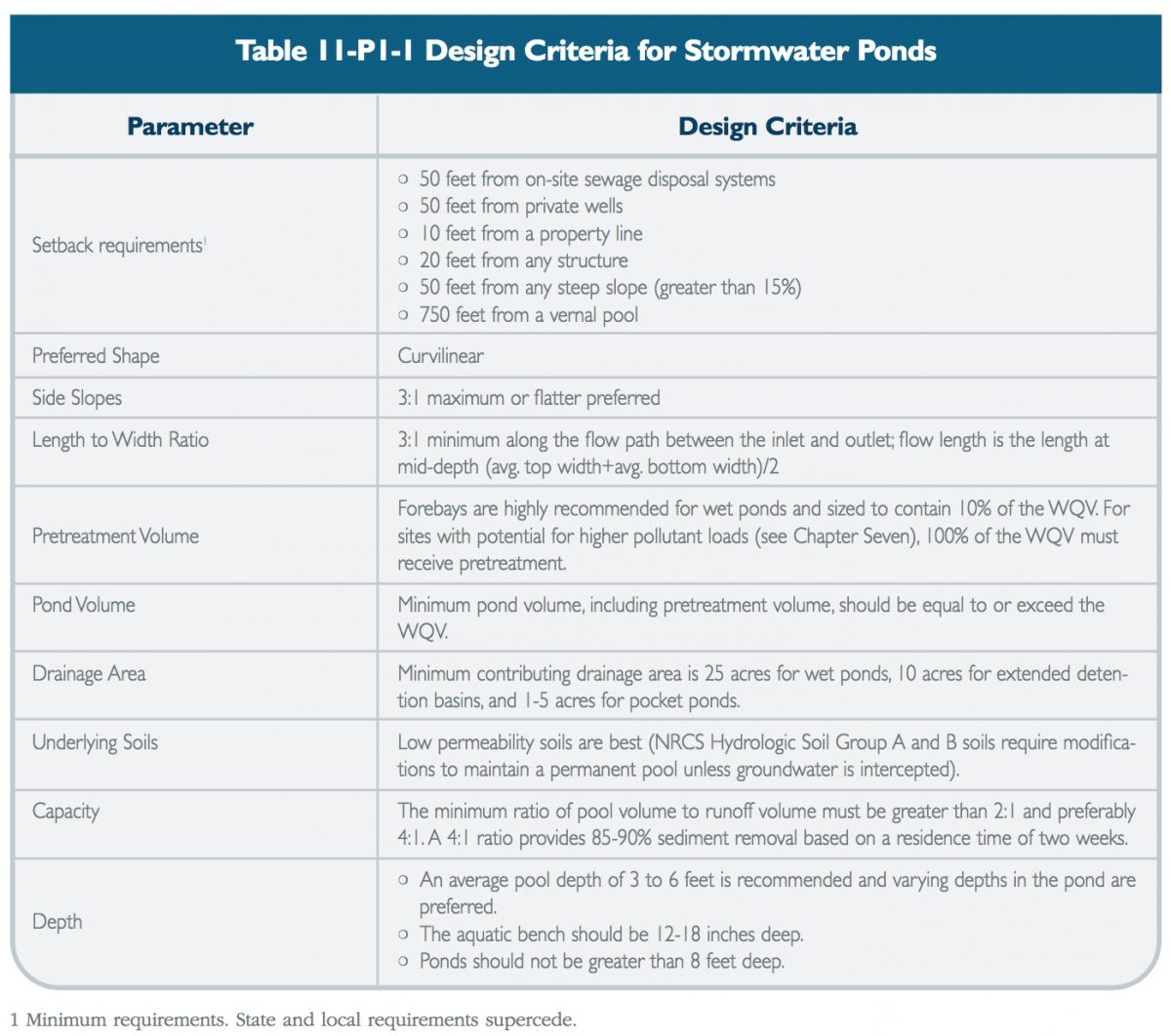
Forebay
A sediment forebay is recommended for all wet pond systems. The purpose of the forebay is to provide pretreatment by settling out coarse sediment particles, which will enhance treatment performance, reduce maintenance, and increase the longevity of a stormwater pond. A forebay is a separate cell within the pond formed by a barrier such as an earthen berm, concrete weir, or gabion baskets.
* The forebay should be sized to contain at least 10% of the WQV and be of an adequate depth to prevent resuspension of collected sediments during the design storm, often being four to six feet deep. The goal of the forebay is to at least remove particles consistent with the size of medium sand. The forebay storage volume may be used to fulfill the total WQV requirement of this system. The forebay must also include additional sediment storage volume that may not be used for WQV calculations.
* The outlet from the forebay should be designed in a manner to prevent erosion of the embankment and primary pool. This outlet can be configured in a number of ways including a culvert, weir, or spillway channel. The outlet should be designed to convey the same design flow proposed to enter the basin. The outlet invert must be elevated in a manner such that 10% of the WQV can be stored below it in addition to the required sediment volume.
* The forebay should have a minimum length to width ratio of 2:1 and a preferred length to width ratio of 3:1.
* Direct access for appropriate maintenance equipment should be provided to the forebay and may include a ramp to the bottom if equipment cannot reach all points within the forebay from the top. The forebay can be lined with a concrete pad to allow easy removal of sediment and to minimize the possibility of excavating subsurface soils or undercutting embankments during routine maintenance.
* A fixed vertical sediment depth marker should be installed in the forebay to measure sediment deposition.
* A barrier, such as an earthen berm, gabions, or a concrete weir may be used to separate the forebay from the permanent pool. This barrier should be armored as necessary to prevent erosion of the embankment if it overtops. This armoring could consist of materials such as riprap, pavers, or geosynthetics designed to resist slope erosion. If a channel is used to convey flows from the forebay to the pond, the side slopes of the channel must be armored as well.
* Additional pretreatment can be provided in the forebay by raising the embankment to provide some detention of incoming flows.
* Sediment storage capacity shall be provided in the forebay as calculated by the Universal Soil Loss Equation in the Connecticut Guidelines for Soil Erosion and Sediment Control.
Wet Pool
Stormwater pond design features primarily enhance the removal of pollutants by increasing the residence time of stormwater in the pond and providing habitat for aquatic plants.
* Provide water quality treatment storage to capture the computed WQV from the contributing drainage area in the proposed forebay, permanent pool, extended detention area, and marsh. The division of storage between the permanent pool and extended detention is outlined in Table 11-P1-2.
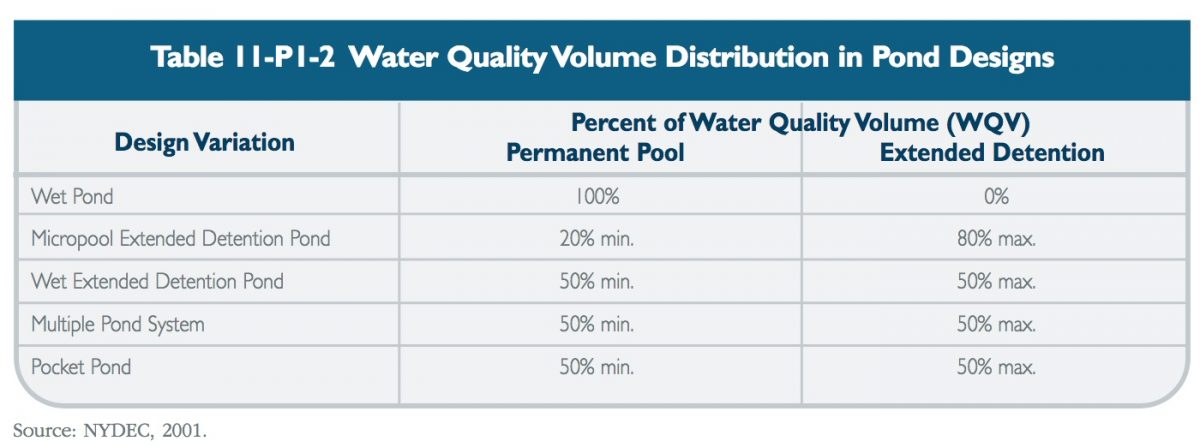
* Water quality storage can be provided in multiple cells. Performance is enhanced when multiple treatment pathways are provided by using multiple cells, longer flow paths, high surface area to volume ratios, complex microtopography, and/or redundant treatment methods (combinations of pool, extended detention, and marsh).
* The minimum pool size should be equal to the WQV. A larger volume should be used to achieve greater pollutant removal when it is necessary to meet specific water quality standards.
* Underwater or marsh berms may be incorporated in the design to lengthen the flow path through the pond.
* Shade should, at a minimum, be provided at least at the pond outlet in an effort to mitigate warming of discharge water.
* The minimum length:width ratio for the pond is 3:1.
* Upper stages of the pond should provide temporary storage of large storms (10, 25, or 100-year events) to control peak discharge rates.
* Provide variable pond depths of 4 to 6 feet but not exceeding depths of 8 feet. Maintaining pond water depths in excess of 4 feet precludes invasive emergent vegetation such as cattails. Emergent vegetation provides mosquito larvae with refuge from predators and increases nutrient availability.
* Chemicals (e.g., aluminum sulfate or alum) can be injected into pond stormwater discharges or added directly to the permanent pool or sediment forebay to enhance removal of fine particulates and dissolved pollutants within the pond.
* Maintain pond water quality sufficient to support mosquito-feeding fish. Stormwater ponds often develop mini-ecosystems where birds, frogs, and other insects feed, many of which are natural predators of mosquitoes and nuisance insects. Ponds can also be stocked with predatory fish native to Connecticut that feed on mosquito larvae such as banded sunfish, flathead minnows, Eastern mud minnows, and several species of killfish. The DEP Fisheries Division should be consulted regarding species selection. Other natural predators of mosquitoes such as dragonfly nymphs can also be used.
Conveyance
Stormwater should be conveyed to and from all stormwater management practices safely and to minimize erosion potential.
Inlet Protection
* The number of inlets should be minimized and one inlet is preferable. The inlet should be located at the most hydraulically remote point from the outlet to minimize the potential for short-circuiting, and should be located in a manner that meets or exceeds desired length to width ratios.
* Inlet areas should be stabilized to ensure that non-erosive conditions exist for the design storm event.
* The ideal inlet configuration is above the permanent pool to prevent potential hydraulic constrictions due to freezing.
Outlet Protection
* The channel immediately below a pond outfall should be modified to prevent erosion and conform to natural topography by use of a plunge pool or a riprap pad and sized for peak discharge velocities.
* Outlet protection should be used to reduce flow to non-erosive velocities from the principal spillway based on actual cover and soil conditions.
* If a pond outlet discharges to a perennial stream or channel with dry weather base flow, tree clearing should be minimized and a forested riparian zone re-established.
* To convey potential flood flows from the basin, an armored emergency spillway should be provided
Pond Liners
* When a pond is located such that the permanent pool does not intercept groundwater, a liner may be needed to maintain minimum water levels. Pond liners are also necessary for ponds that may present a risk to groundwater quality. Table 11-P1-3 lists recommended specifications for clay and geomembrane liners.
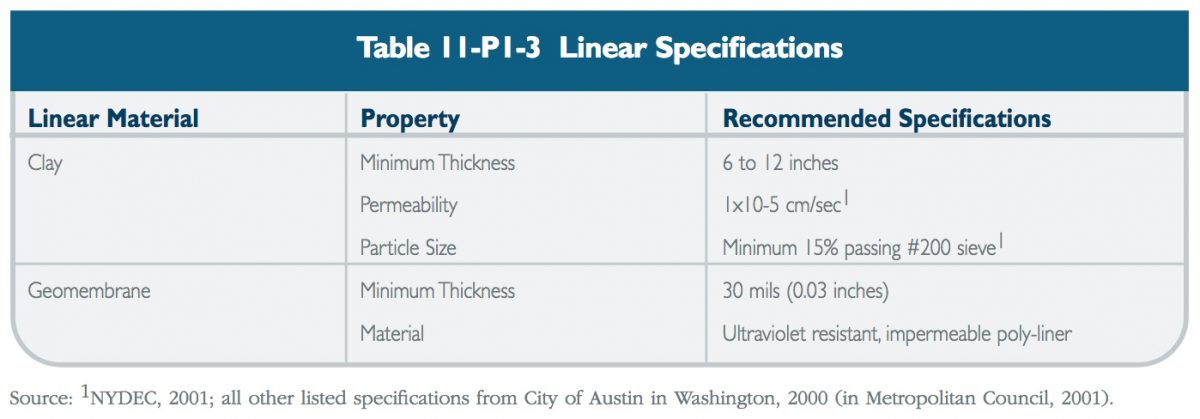
Pond Benches
* For pond side slopes steeper than 4:1, provide a flat safety bench that extends 10 feet outward from the normal water edge to the toe of the pond side slope.
* Incorporate a flat aquatic bench that extends 10 feet inward from the normal shoreline at a depth of 12-18 inches below the normal pool water surface elevation.
Maintenance Reduction Features
In addition to regular maintenance activities needed to maintain the function of stormwater practices, some design features can be incorporated to ease the maintenance burden of each practice. In wet ponds, maintenance reduction features include techniques to reduce the amount of maintenance needed, as well as techniques to make regular maintenance activities easier.
* Ponds should be designed with non-clogging outlets, such as a weir, or by incorporating trash racks for culverts and orifice openings.
* To prevent clogging from ice or floatables, a reverse slope outlet pipe can be used to draw water from below the permanent pool up to the outlet structure. The invert of the pipe drawing from the pool should be at least 18 inches from the bottom to prevent sediment discharge.
* No orifice should be less than 6 inches in diameter with a trash rack to prevent clogging.
* Ponds should have a manually operated drain to draw down the pond for infrequent maintenance or dredging of the main cell of the pond.
* Metal components of outlet structures should be corrosion resistant, but not galvanized due to the contribution of zinc to water (Washington, 2001).
* Outlet structures should be resistant to frost heave and ice action in the pond.
Landscaping
Constructing landscaped wet ponds can enhance their aesthetic value. Aquatic plantings around the edge of the pond can provide pollutant uptake, stabilize the soil at the edge of the pond, and improve habitat. Maintaining high vegetation along the edge of the pond (not mowing to the edge) can also deter waterfowl access and filter pollutants.
* Wetland plantings should be encouraged in a pond design, either along the aquatic bench (fringe wetlands), the safety bench and side slopes, or within shallow areas of the pool.
* The best depth for establishing wetland plants, either through transplantation or volunteer colonization, is within approximately six inches of the normal pool elevation.
* Soils should be modified (e.g., scarified or tilled) to mitigate compaction that occurs during construction around the proposed planting sites.
* Avoid species that require full shade, are susceptible to winterkill, or are prone to wind damage.
* Woody vegetation may not be planted or allowed to grow within 25 feet of the toe of the embankment and 25 feet from the principal spillway structure.
* Existing trees should be preserved in the buffer area during construction. It is desirable to locate forest conservation areas adjacent to ponds. To help discourage resident geese populations, the buffer can be planted with trees, shrubs, and native ground covers.
* Annual mowing of the pond buffer is only required along maintenance rights-of-way and the embankment. The remaining buffer can be managed as a meadow (mowing every other year) or forest.
* Plant the pond with salt-tolerant vegetation if the stormwater pond receives road runoff.
Cold Climate Pond Design Considerations
The following design elements should be considered to minimize potential performance impacts caused by cold weather:
* Inlet pipes should not be submerged, since this can result in freezing and upstream damage or flooding.
* Bury all pipes below the frost line to prevent frost heave and pipe freezing. Bury pipes at the point furthest from the pond deeper than the frost line to minimize the length of pipe exposed.
* Increase the slope of inlet pipes to a minimum of 1%, if site conditions allow, to prevent standing water in the pipe and reduce the potential for ice formation.
* If perforated riser pipes are used, the minimum orifice diameter should be 0.5 inches. In addition, the pipe should have a diameter of at least 6 inches.
* When a standard weir is used, the minimum slot width should be 3 inches, especially when the slot is tall.
* Baffle weirs can prevent ice formation near the outlet by preventing surface ice from blocking the inlet, encouraging the movement of base flow through the system.
* In cold climates, riser hoods and reverse slope pipes should draw from at least 6 inches below the typical ice layer. This design encourages circulation in the pond, preventing stratification and formation of ice at the outlet. Reverse slope pipes should not be used for off-line ponds.
* Trash racks should be installed at a shallow angle to prevent ice formation.
* Additional storage should be provided to account for storage lost to ice buildup. Ice thickness may be estimated by consulting with local authorities (the fire department, for example) with knowledge of the typical ice thickness in the area.
Construction
* Any stormwater treatment practices that create an embankment, including stormwater ponds, are under the jurisdiction of the Dam Safety Section of the Connecticut DEP Inland Water Resources Division (IWRD) and should be constructed, inspected, and maintained in accordance with Connecticut General Statutes Sections 22a-401 through 22a-411, inclusive, and applicable DEP guidance.
* Avoid soil compaction to promote growth of vegetation.
* Temporary erosion and sediment controls should be used during construction and sediment deposited in the stormwater pond should be removed after construction.
* Appropriate soil stabilization methods should be used before permanent vegetation is established. Seeding, sodding, and other temporary soil stabilization controls should be implemented in accordance with the Connecticut Guidelines for Soil Erosion and Sediment Control.
* Temporary dewatering may be required if excavation extends below the water table. Appropriate sedimentation controls will be required for any dewatering discharges.
Inspection and Maintenance
* Plans for stormwater ponds should identify detailed inspection and maintenance requirements, inspection and maintenance schedules, and those parties responsible for maintenance.
* The principal spillway should be equipped with a removable trash rack, and generally accessible from dry land.
* Sediment removal in the forebay should occur at a minimum of every five years or after the sediment storage capacity in the forebay capacity has been filled.
* Sediment removed from stormwater ponds should be disposed of according to an approved comprehensive operation and maintenance plan.
* Recommended maintenance activities for stormwater ponds are summarized in Table 11-P1-4.
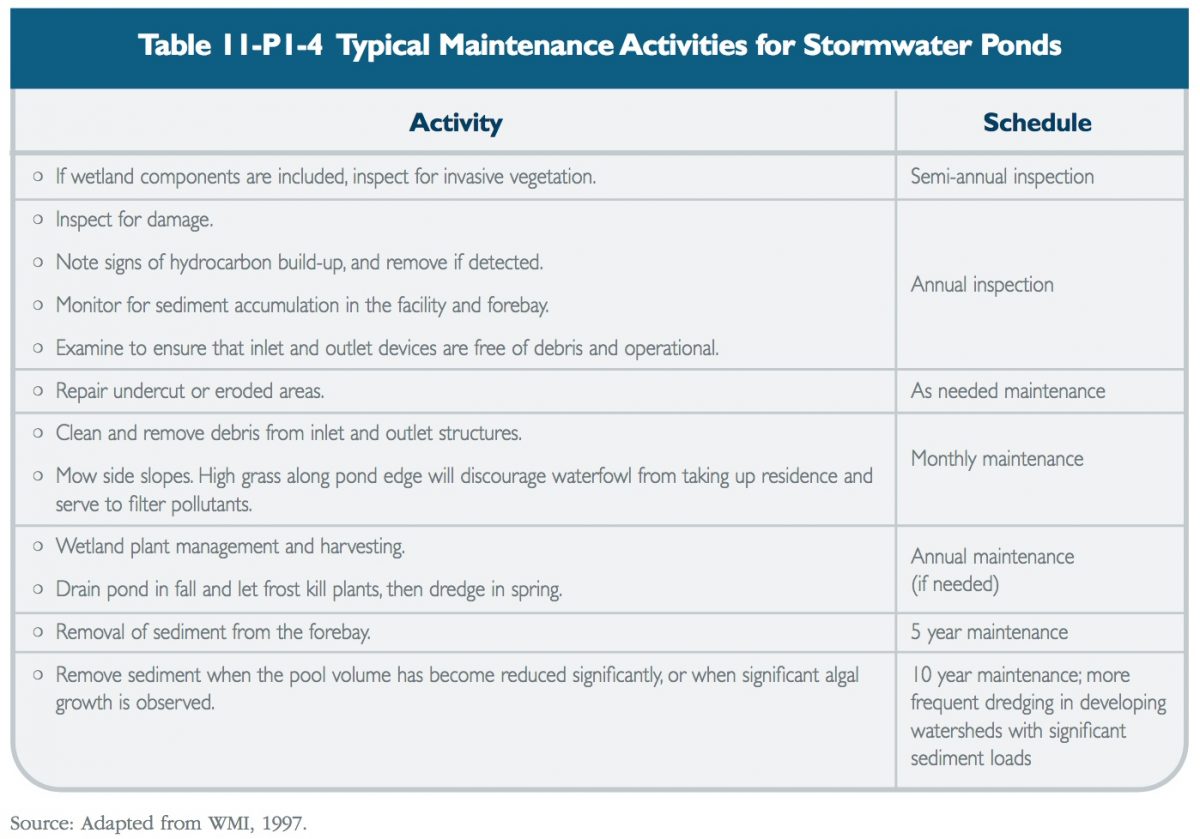
Maintenance Access
* A maintenance right of way or easement should extend to the pond from a public road.
* Maintenance access should be at least 12 feet wide, have a maximum slope of no more than 15%, and be appropriately stabilized to withstand maintenance equipment and vehicles.
* The maintenance access should extend to the forebay, safety bench, riser, and outlet and be designed to allow vehicles to turn around.
Non-clogging Low Flow Orifice
* A low flow orifice shall be provided, with the size of the orifice sufficient to ensure that no clogging will occur.
* The low flow orifice should be adequately protected from clogging by either an acceptable external trash rack (recommended minimum orifice of 6 inches) or by internal orifice protection that may allow for smaller diameters (minimum of 1 inch).
* The preferred method is a submerged reverse-slope pipe that extends downward from the riser to an inflow point one foot below the normal pool elevation.
* Alternative methods are to employ a broad crested rectangular, V-notch, or proportional weir, protected by a half-round pipe that extends at least 12 inches below the normal pool level.
* The use of horizontally extended perforated pipe protected by geotextile fabric and gravel is not recommended. Vertical pipes may be used as an alternative if a permanent pool is present.
Riser in Embankment
* The riser must be located within the embankment for maintenance access, safety and aesthetics.
* Lockable manhole covers and manhole steps within easy reach of valves and other controls should provide access to the riser. The principal spillway opening should be “fenced” with pipe at 8-inch intervals for safety purposes.
Pond Drain
* Except where local slopes prohibit this design, each pond should have a drain pipe that can completely or partially drain the pond. The drain pipe shall have an elbow or protected intake within the pond to prevent sediment deposition in the pipe, and a diameter capable of draining the pond within 24 hours.
* Pond retention times can be increased to enhance water quality control during storm events by maintaining ponds at low levels before storms and increasing the available pond volume during storms.
* Care should be exercised during pond draining to prevent rapid drawdown and minimize downstream discharge of sediments or anoxic water. The approving jurisdiction should be notified before draining a pond.
Adjustable Gate Valve
* Both the WQV extended detention pipe and the pond drain may be equipped with an adjustable gate valve (typically a handwheel activated knife gate valve).
* Valves should be located inside of the riser at a point where they (a) will not normally be inundated and (b) can be operated in a safe manner.
* Both the WQV extended detention pipe and the pond drain should be sized one pipe size greater than the calculated design diameter.
* To prevent vandalism, the handwheel should be chained to a ringbolt, manhole step, or other fixed object.
Safety Features
* Side slopes to the pond should not exceed 3:1 and should terminate at a safety bench.
* The principal spillway opening must not permit access by small children, and endwalls above pipe outfalls greater than 48 inches in diameter must be fenced to prevent a hazard.
* Both the safety bench and the aquatic bench may be landscaped to prevent access to the pool.
* Warning signs prohibiting swimming and skating may be posted.
* Pond fencing is generally not encouraged, but may be required by some municipalities. The preferred method is to grade the pond to eliminate dropoffs or other safety hazards.
Cost Considerations
Wet ponds are relatively inexpensive stormwater practices, but costs vary widely depending on the complexity of the design or difficulty of site constraints. The costs of stormwater ponds may be estimated using the following equation (Brown and Schueler, 1997):
C = 24.5V0.705
where: C = Construction, design, and permitting cost.
V = Volume in the pond to include the 10-year storm (ft3).
Costs should be adjusted for inflation to reflect current costs. The annual cost of routine maintenance is typically estimated at about 3 to 5 percent of the construction cost (EPA Wet Pond Fact Sheet, http://www.epa.gov/npdes/menuofbmps/menu.htm). Ponds typically have a design life longer than twenty years.
References
Brown, W. and Shueler, T. 1997. The Economics of Stormwater BMPs in the Mid-Atlantic Region. Center for Watershed Protection. Elliot City, MD.
Galli, F. 1990. Thermal Impacts Associated with Urbanization and Stormwater Best Management Practices. Metropolitan Washington Council of Governments. Prepared for: Maryland Department of the Environment. Baltimore, MD.
Metropolitan Council. 2001. Minnesota Urban Small Sites BMP Manual: Stormwater Best Management Practices for Cold Climates. Prepared by Barr Engineering Company. St. Paul, Minnesota.
New York State Department of Environmental Conservation (NYDEC). 2001. New York State Stormwater Management Design Manual. Prepared by Center for Watershed Protection. Albany, New York.
Oberts, G. 1994. Performance of Stormwater Ponds and Wetlands in Winter. Watershed Protection Techniques 1(2): 64-68.
Schueler, T. 1997. Influence of Groundwater on Performance of Stormwater Ponds in Florida. Watershed Protection Techniques 2(4): 525-528.
United States Environmental Protection Agency (EPA). 2002. National Menu of Best Management Practices for Stormwater Phase II. URL: http://www.epa.gov/npdes/menuofbmps/menu.htm, Last Modified January 24, 2002.
Washington State Department of Ecology (Washington). 2000. Stormwater Management Manual for Western Washington, Final Draft. Olympia, Washington.
Watershed Management Institute (WMI). 1997. Operation, Maintenance, and Management of Stormwater Management Systems. Prepared for U.S. Environmental Protection Agency. Office of Water. Washington, D.C.
